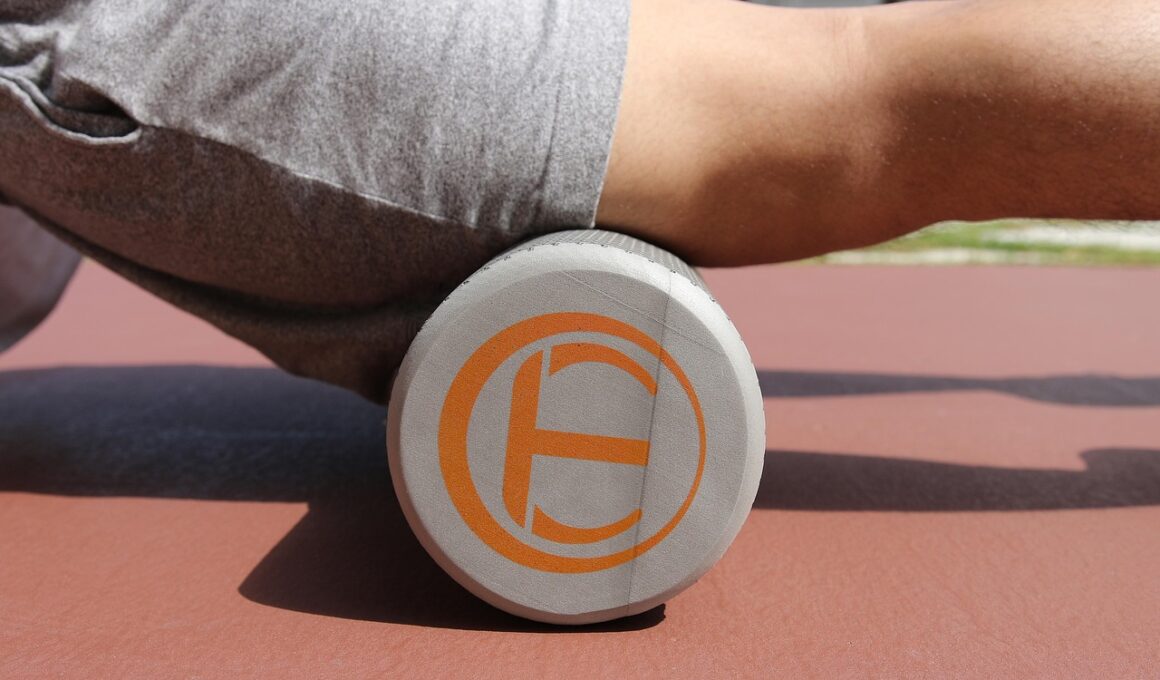How to Use Foam Rolling to Enhance Muscle Recovery
Foam rolling is a highly effective technique used in post-workout recovery that has gained significant popularity among athletes and fitness enthusiasts. This method involves rolling a cylinder-shaped foam piece across sore or tight muscles. The practice enhances blood flow, alleviates muscle soreness, and significantly speeds up recovery. Moreover, foam rolling can help improve flexibility and range of motion, which may lead to more effective workouts in the future. The key is to apply the right amount of pressure on targeted muscle areas, ensuring the foam penetrates the muscle tissue. This technique not only aids recovery but also allows for self-myofascial release, addressing muscle knots and stiffness. Foam rolling is particularly beneficial after strength training, where lactic acid often accumulates in the muscles, causing soreness. By integrating foam rolling into your routine, you can help your body recover faster and perform better. Most importantly, foam rolling is accessible and can be performed anywhere, making it a valuable addition to any post-workout regimen. Incorporating this practice regularly can result in long-term benefits for muscle recovery and overall fitness efficiency.
To effectively incorporate foam rolling into your post-workout routine, it’s essential to understand the best techniques and practices. Begin by choosing the right foam roller; there are various densities available, from soft to firm. Beginners may find it beneficial to use a softer roller, while advanced users might prefer a firmer option. Start with the larger muscle groups, such as the thighs, calves, and back, allowing time to address each area thoroughly. When rolling, apply steady, controlled pressure and roll slowly over each muscle group for approximately 30-60 seconds. If you encounter tender spots or knots, pause on that area to help release the tension. The rolling motion should be neither painful nor uncomfortable, so listen to your body and adjust the pressure accordingly. Another critical aspect is to maintain proper hydration during your workouts, as staying hydrated can enhance the effectiveness of foam rolling. Remember to breathe deeply, as this helps relax your muscles as you roll. Scheduling your foam rolling sessions regularly can improve blood flow and reduce muscle tightness, making recovery smoother and less fatigued overall. Incorporate this method to boost your fitness journey.
The Science Behind Foam Rolling
The effectiveness of foam rolling stems from its ability to stimulate blood circulation and break up muscle stiffness. A study conducted by researchers highlighted foam rolling’s positive impact on delayed onset muscle soreness (DOMS), which commonly occurs after intense workouts. By applying pressure to the muscles, foam rolling triggers a process known as self-myofascial release, which helps alleviate tensions within the fascial connective tissue. This process not only enhances flexibility but also allows for improved muscular function. Foam rolling can also increase endorphin production while decreasing cortisol levels, enabling better pain management during recovery. The rhythmic rolling action can encourage a temporary increase in muscle performance by improving the muscle’s extensibility and promoting a quicker return to the normal state post-exercise. Furthermore, initiating foam rolling right after workouts can significantly influence physical well-being and performance, leading to quicker recovery times in the long run. As you familiarize yourself with foam rolling, integrating various techniques can bring optimal results, providing a solid foundation for your post-workout regimen while addressing any muscle discomfort effectively.
It’s crucial to recognize the ideal times and methods for foam rolling within your training regimen to maximize recovery benefits. Ideally, foam rolling can be performed both pre- and post-workout. Engaging in a few minutes of foam rolling as part of your warm-up routine helps prepare muscles for the upcoming workout. This can lead to increased blood flow, enhanced muscle elasticity, and reduced risk of injuries. Post-workout foam rolling focuses on recovery by addressing tightness and soreness as muscles heal. Depending on your training intensity, you may want to adjust the duration and pressure of your foam rolling sessions. Straightforward techniques such as gentle rolls on the foam, focusing on major muscle groups, or specific knots can provide the necessary relief. It’s important to be consistent, stretching muscles more often after exercise can greatly benefit overall recovery. Additionally, combining foam rolling with other recovery techniques like hydration, nutrition, and rest creates a comprehensive recovery strategy. Achieving a well-rounded post-workout routine ensures your body can perform at its best, making foam rolling an essential practice for athletes of all levels.
Common Mistakes to Avoid
While foam rolling is beneficial, there are several common mistakes that individuals often make which reduce its effectiveness. One prevalent mistake is rolling too quickly over the muscles; it’s essential to maintain a slow, controlled movement to apply adequate pressure on the targeted areas. Additionally, many people neglect to breathe properly while foam rolling, which can lead to muscle tension. Focus on taking deep, consistent breaths to promote relaxation during the process. It’s also crucial to roll major muscle groups rather than just focusing on one area for too long; this ensures that you address tightness throughout your body evenly. Another mistake is using excessive pressure, often resulting in pain or damage. Instead, adjust your body positioning to control the pressure rather than forcing the roller into the muscle. Lastly, ensure that you aren’t rolling over bony areas, as this can cause discomfort. Being mindful of these common pitfalls can enhance your foam rolling experience significantly and lead to better long-term results. By avoiding these mistakes, you can fully enjoy the benefits foam rolling has to offer with an informed approach.
To further enhance the effectiveness of foam rolling, consider incorporating complementary methods along with your routine. Stretching after foam rolling can help lengthen the muscle fibers and encourage further relaxation, contributing to overall recovery. Research suggests that combining foam rolling with static stretching maximizes its benefits by enhancing your range of motion. Furthermore, it can help in preparing your muscles for the next workout session. Adding dynamic stretches before your workouts can also contribute to optimal performance. Nutrition plays a vital role in recovery; consuming a balanced post-workout meal rich in protein and carbohydrates helps replenish energy stores and promote muscle repair. Adequate hydration is also essential to maintain optimal performance and recovery. Listening to your body is important; if you feel persistent soreness or pain during foam rolling, consult with a healthcare provider for guidance. Field-testing various foam rolling techniques, durations, and frequencies can provide insights into what works best for you as an individual. This tailored approach can lead to better results and enhance your overall fitness journey, promoting peak performance throughout your training.
Conclusion
In conclusion, foam rolling presents an advantageous strategy for anyone looking to enhance muscle recovery post-workout. This cost-effective, portable tool can provide immediate benefits in alleviating soreness and improving muscle function. By incorporating foam rolling into your post-workout routine, alongside proper hydration and nutrition, you’re setting yourself up for better fitness outcomes and improved performance. Regular practice can help prevent injuries and maintain flexibility, contributing positively to your overall well-being. Additionally, understanding key techniques and avoiding common mistakes ensures a more effective foam rolling experience, leading to excellent results over time. Implementing consistency will provide you with the most significant benefits over your fitness journey. Take the opportunity to explore different foam rollers in the market to find your best fit, considering sizes and densities that suit your personal comfort. As this practice becomes a regular part of your routine, you’ll likely notice a marked difference in muscle recovery and overall performance. Investing time in your recovery is crucial, and foam rolling is an effective way to achieve those benefits with minimal effort and equipment.
Overall, foam rolling is a powerful technique that should not be overlooked when devising a post-workout recovery plan. Not only does it ease muscle soreness, but it also enhances overall performance both short-term and long-term. With the right approach, foam rolling can significantly contribute to your fitness journey, providing the relief and recovery that your muscles need after intense workouts. Incorporate foam rolling into your routine today to experience its transformative impact on muscle recovery and athletic performance, ensuring a healthier and more enjoyable fitness experience.


